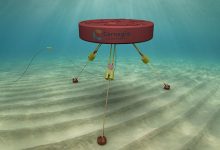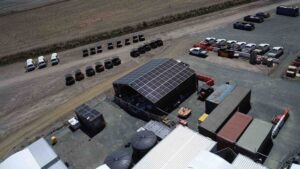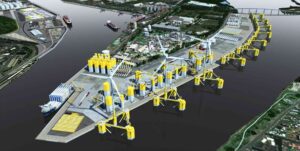Troubled wave energy developer Carnegie Clean Energy is seeking to reboot the development of its wave energy technologies with the release of a new prospectus to the Australian Stock Exchange that will seek to raise $5.4 million.
Carnegie will offer existing shareholders the option of purchasing new shares in the company, through a 4-for-1 offer at just 0.1 cents per share as it seeks to recapitalise the business after the company’s foray into solar microgrids ended in disaster.
Carnegie has been the leading developer of wave energy technologies in Australia, winning substantial government support for the development of wave energy prototypes, including the completion of the Albany Wave Energy Project, and the deployment of an operational example of the company’s 1.5MW CETO6 wave energy unit.
The company successfully deployed the example of the 5th generation of its CETO technology off the coast of Garden Island, near Perth in 2014, feeding electricity into the Western Power Network.
But the failure of microgrid subsidiary Energy Made Clean (EMC) left Carnegie with insufficient funds to complete the project, leading to the termination of funding support from the Western Australian Government.
This was the final straw for the company, which was subsequently placed into voluntary administration. KordaMentha was appointed as the company’s administrator in March, and sought to wind down the EMC subsidiary, and to provide a pathway for the recapitalisation of the wave energy component of the company.
Creditors voted in support of a recapitalisation proposal on April, with unsecured creditors in the company likely to receive a return of just 10 cents for each dollar of debt and equity held in the previous iteration of the company.
With the company now having shed the EMC subsidiary, with no further losses expected from that arm of the company, Carnegie is hoping that the remaining shareholders will support the company’s attempts to re-enter the wave energy space. It says it will focus on cheaper research and development methods,
“Carnegie has now addressed the previous problems with the company, which stemmed from the failed EMC business,” chairman Terry Stinson says in a statement.
“The company’s difficulties in completing the Albany Wave Energy Project arose primarily from the significant cash losses incurred by that EMC business and proposed R&D tax changes.
“This left the company unable to finance the project, which was the cause of the project not being completed, rather than any failure or loss of confidence in our core wave power technology.”
The $5.5 million capital raising will allow the company to become operational again, including the re-engagement of key personnel, but the company acknowledges that a further capital or debt raising may be needed in the future to progress the business, particularly if it wants to undertake the construction of an operating example of the CETO wave generator.
Carnegie hopes that by refining the design of the CETO wave energy system, it will be able to deploy large-scale electricity generation projects using wave energy at a price that is competitive with off-shore wind.
Carnegie will take a new approach to the development of its wave technology, switching to a lower cost method of using computational modelling and virtual prototyping to develop designs of its wave energy generation technologies.
Previously, Carnegie had developed its technologies through an “engineering heavy” approach, of constructing working prototypes and making iterative improvements to the designs based on their performance.
“Our plan is simple, to move the technology development into a hi-tech pathway of building a digitised virtual prototype using emerging computational mean such as artificial intelligence (Machine Learning) and leveraging our important strategic relationships,” it says.
“This pathway is intended to be significantly quicker and require substantially less funds.”
Shares in Carnegie Clean Energy once traded as high as 23 cents per share in 2010, but after a encountering difficult environment for the development of the wave energy technologies, and the troubles caused by the EMC acquisition, the share price slumped, falling to just 0.3 cents at the point the company entered voluntary administration.










